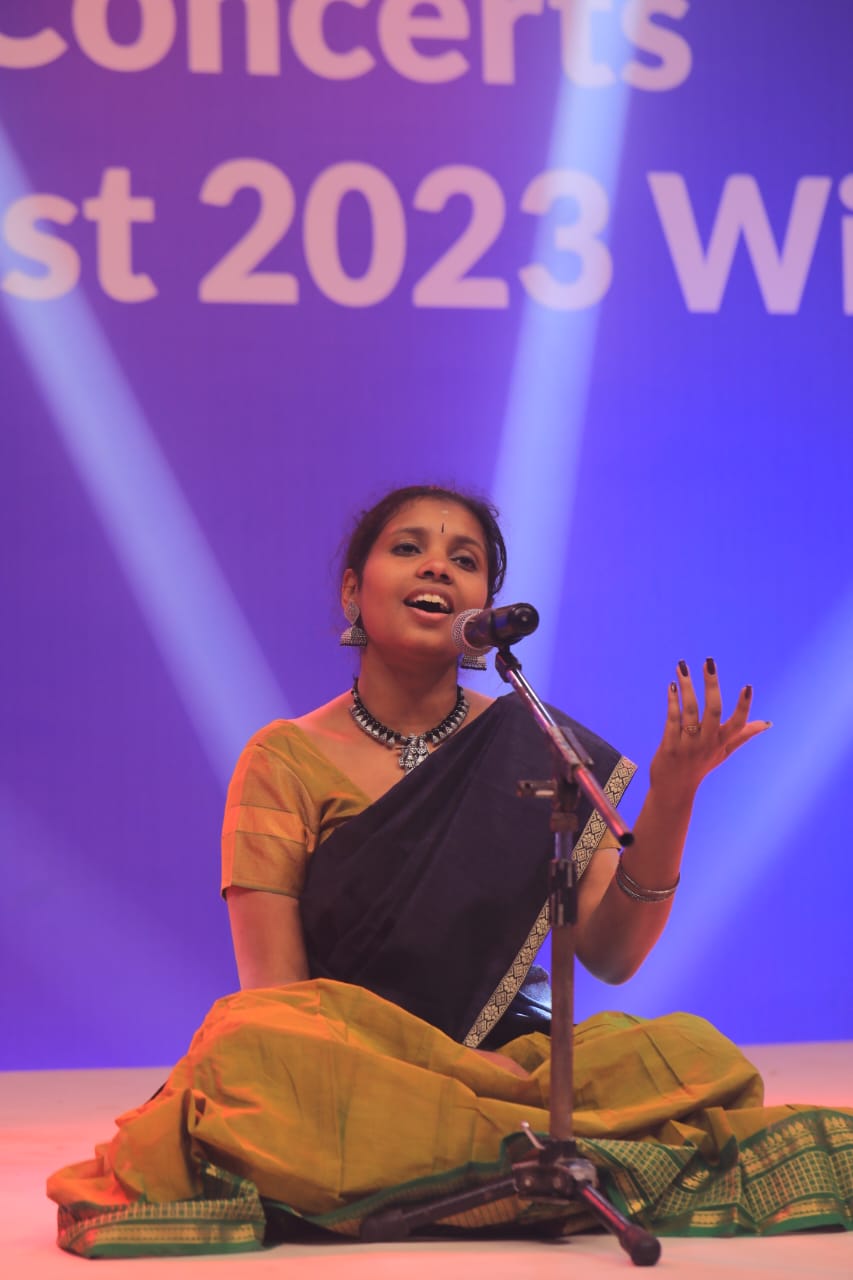Understanding the Tradition: Samagaana snd Sangeetha
Kum. Aditi B Prahalad is a distinguished Carnatic classical vocalist from Bengaluru, recognized as a child prodigy in the realm of Carnatic Classical Vocal music. She began her musical journey at the age of five under the guidance of Vidwan Kamal Kumar and Sri Narahari Dixit. Currently, she continues her training under Vidwan Vinay Sharva .
Aditi has performed in several live concerts in both Carnatic classical and light music. Some of her notable performances include singing at prestigious events like the Hampi Utsav, Mysore Dasara Festival, and in front of President Pranab Mukherjee at Rashtrapati Bhavan.
In addition to her musical pursuits, Aditi completed her Bachelor’s in Engineering in Computer Science from 2019 to 2023 and is currently pursuing a Master’s in Fine Arts from Madras University.
In this interview she speaks about Heritage Trust’s programs on Samagaana and Sangeetha.
Could you explain the distinction between Swara Samagaana and Shastriya Sangeeth? How do they intersect historically?
Swara is the basic musical note — the building block of melody. Samagaana is the earliest use of these swaras, found in the Samaveda, where Vedic hymns were sung melodically. Shastriya Sangeetha is the classical music system that evolved later, formalizing swaras into ragas, talas, and aesthetics. Historically, it’s a journey from divine chant to artistic expression.
How does Samagaana, as part of the Vedic tradition, influence the melodic and rhythmic structures of Indian classical music today?
Samagaana is basically how the Sama Veda was sung — not just recited, but actually sung with melody. Each word was given a musical note, and the way they sang it had a pattern — that’s where our swaras began. Even the rhythm was there, though not as structured as today’s tala, but it gave a sense of timing.
So in a way, what we now call classical music — with ragas, swaras, and talas — all has its roots in this ancient way of singing the Vedas. It started with devotion, with sound as a form of prayer, and over time became the beautiful system of music we have today
In your view, what is the spiritual or meditative dimension of Swara Samagaana compared to concert-oriented Shastriya Sangeeth?
Swara Samagaana, especially in its Vedic context, was never about performance — it was about connecting to the divine. The chanting was slow, deliberate, and deeply meditative. Each swara wasn’t just a note, it was a vibration meant to awaken something within — a kind of inner tuning.
Shastriya Sangeeth, or classical music as we know it today, has evolved into a performance art. But even here, at its core, when done with bhava (emotion) and shraddha (devotion), it still holds that same power — to move inward, to elevate.
Techniques and Practice
What role do intonation and precision of swaras play in Samagaana versus in modern classical renditions?
In Samagaana, precision of swaras isn’t just musical — it’s sacred. Each note is chanted with exact intonation because it’s tied to the power of the mantra. Even a slight variation in pitch could change the meaning or reduce its spiritual potency. That’s why Samaveda prescribes very specific tonal patterns using notations like udātta, anudātta, and svarita. It’s like tuning into a cosmic frequency.
In classical music today, we also care deeply about swara shuddhi (purity of notes), but the context is different. There’s more emotional play, freedom, and aesthetic exploration. We bend notes (gamakas), improvise, and use ragas to create rasa (emotion). So while both traditions value precision, Samagaana treats it as a spiritual discipline, and Shastriya Sangeet uses it as a base for creative and expressive beauty.
How is tala (rhythm) treated in Samagaana, given that it is often more free-flowing than in structured kriti or raag performance?
In Samagaana, rhythm — or tala as we know it today — isn’t rigid or marked by hand gestures or beats like in classical concerts. It’s much more fluid and organic. The rhythm flows along with the chanting of the mantras, guided by the syllables, accents (svaras), and breath. It’s more about the natural cadence of Vedic recitation than following a set rhythmic cycle.
In contrast, in Shastriya Sangeet, tala is a very structured and mathematical system. We have precise cycles — like Adi Tala, Rupaka Tala — and compositions are crafted to fit within these frameworks, allowing for improvisation and rhythmic play.
Do you think Shastriya Sangeeth can regain some of the meditative or spiritual grounding found in Samagaana?
Yes, definitely. In fact, I believe Shastriya Sangeeth can and should reconnect with its meditative and spiritual roots — because that’s where it originally came from. Samagaana wasn’t just music, it was a form of prayer, a bridge to the divine. Every note (swara) had intention, every pause had purpose.
Over time, classical music evolved with performance, structure, and expression, which is beautiful in its own way. But when an artist approaches it not just as entertainment, but as a sadhana — a spiritual journey — the bhava, the emotion, and the depth returns.
If we sing a raga with that same sense of stillness and surrender that the Vedic chanters had — then yes, Shastriya Sangeeth becomes just as meditative, powerful, and transformative.

